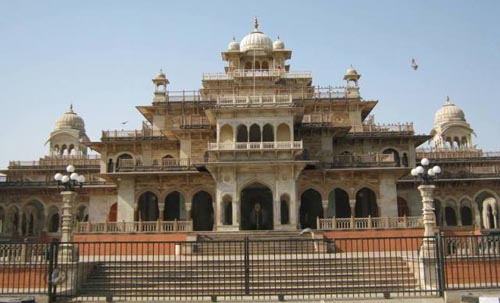Albert Hall Museum

Information on Albert Hall Museum (Jaipur, Rajasthan) - History & Architecture
Albert Museum Hall is one of the oldest museums in Rajasthan. The museum is located in the central point of Ram Nivas garden. It was established by Samuel Swinton Jacob and become accessible to the public in the year 1887. King Ram Singh primarily desired the museum to be a town hall, however, his descendant, Madho Singh II decided the building to be a museum in order to demonstrate the art of Jaipur and hence was incorporated as a portion of Ram Nivas garden. At present, Albert Museum Hall possess amusing collection of articles such as paintings, mats, ivory, stone, metallic statues and multi-coloured crystal works among others.
Albert Hall Museum Architecture
Albert Museum Hall is probably the most pretty and visually spectacular architecture among many architectural extremes of Jaipur. The building itself is regarded as a central part of attraction. The structure of the building is based on Indo-Saracenic architecture with wide-ranging traditional Indian designs from Mughal and Rajput. The passageways of the museum is ornamented with paintings in variety of styles comprising the Ramayana and Persian paintings. Furthermore, European, Chinese, Egyptian and Greece among other civilisations were also demonstrated in Albert Museum Hall, allowing global travellers to compare and contrast the cultures and also to enhance the knowledge base regarding history and art.
Albert Hall Museum History
Albert Hall was established in the year 1876 for ensuring that Prince Albert, husband of queen Victoria of England visit Jaipur throughout his tour in India. The name itself has been chosen in order to give tribute to Prince Albert and to attract him towards Jaipur. It was crucial for king Ram Singh to motivate prince for visiting Jaipur because such tour was supposed to strengthen the relationship of the king with British royal court. This exaggerated gesture had assured the visit of prince and presently, Albert Hall has transformed into Albert Museum.
During the foundation of Albert Museum Hall in the year 1876, there was certain recommendations concerning the cultural and educational use of the hall. Nevertheless, in the year 1880, a recommendation provided by Thomas Holbein Hendley to open a museum of industrial arts in order to demonstrate the works of local craftsman was accepted by the king. Moreover, Hendley also organised an exhibition in Jaipur in the year 1883 for familiarising local craftsman with best samples of Indian art and handcrafts. The objective of the exhibition was to safeguard and reserve the traditional art, to instruct youth in extensive diversity of areas and to notify people regarding Jaipur. The construction of Albert Museum Hall was finished in the year 1887. Artefacts from various parts of India was gathered in the hall and were amalgamated to the new museum. The museum signify the vision of king Ram Singh which was appreciated by his descendant king Sawai Madho Singh who demonstrated new look of Jaipur, transforming towards modern phase.
Albert Hall Museum Tourism Importance
Albert Museum Hall is regarded as a centre for communicating knowledge regarding history of civilisations. It demonstrates Indian arts, handcrafts and architectural structures which can amuse and teach the travellers. Albert Museum Hall is best way to obtain a clear knowledge regarding the rich Indian culture. It displays pottery, statues, clothing of royal members, metallic objects and several arts and craftsmanship, allowing intense idea to the travellers regarding history of Jaipur.
- Andaman Nicobar Monuments
- Andhra Pradesh Monuments
- Assam Monuments
- Bihar Monuments
- Chhattisgarh Monuments
- New Delhi Monuments
- Goa Monuments
- Gujarat Monuments
- Haryana Monuments
- Himachal Pradesh Monuments
- Jammu and Kashmir Monuments
- Karnataka Monuments
- Kerala Monuments
- Madhya Pradesh Monuments
- Maharashtra Monuments
- Odisha Monuments
- Punjab Monuments
- Rajasthan Monuments
- Tamil Nadu Monuments
- Telangana Monuments
- Uttar Pradesh Monuments
- West Bengal Monuments